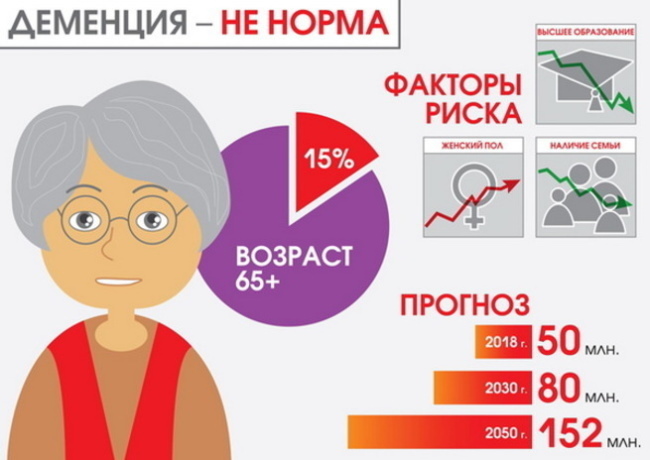Coma in humans - This is a serious brain damage that can cause death, leading to a complete loss of consciousness and disruption of all neuropsychic activity.
The pathology translated from the Greek language "deep sleep" can be caused by serious injuries, tumors or infectious damage to the body, and is lowly accompanied by signs: deep loss of consciousness, lack of motor and reflex functions.
Record content:
- 1 Coma concept
- 2 Reasons for the appearance
-
3 Types of coma
- 3.1 Traumatic
- 3.2 Epileptic
- 3.3 Cerebral
- 3.4 Hungry
- 3.5 Minengial
- 3.6 Hypoglycemic
- 3.7 Diabetic
- 4 Stages of development of the disease
- 5 Symptoms and Signs
- 6 Diagnostic methods
- 7 Pathology treatment
- 8 Disease prognosis
- 9 Coming out of a coma
- 10 Coma video
Coma concept
A coma in a person (signs are usually very clear) is a life-threatening condition caused by trauma to the structure the brain and leading to the complete absence of any mental activity in the patient, as well as communication with the environment his world.
The damage to the brain is so deep that the patient ceases to respond to any, even the most powerful external stimuli, and even intense stimulation can not get out of this state.
A coma patient lies with his eyes closed, does not react to sound and bright light. There is also no human reaction to severe pain.
All other signs: lack of spontaneous breathing, preservation or absence of reflexes, heart rhythm disturbances, may join later or be completely absent, depending on the degree of injury to the patient and the reason that caused the coma.
Pathology is understood as a very deep sleep provoked by damage to the part of the brain responsible for the consciousness and wakefulness of a person.
Reasons for the appearance
A coma in a person (the signs are, first of all, in an unconscious state) is not an independent pathology, but only a complication resulting from severe damage to the nerve pathways.
Due to the fact that the cerebral cortex does not perceive signals from the outside world directly, but only through reticular formation, damage to the cells of the latter and leads to the loss of communication of the human brain with the external the world. The fibers of the reticular formation can be damaged as a result of physical exposure or under the influence of chemicals.
- By physical impact, it is customary to understand a severe brain injury caused by bruising, hemorrhage, bullet wound, cerebral stroke.
- Chemical exposure can be caused by internal problems associated with diseases of the internal organs or external factors leading to severe intoxication with narcotic, psychotropic or poisonous substances.
Internal problems that provoke the appearance of a coma are most often associated with:
- with severe hypoxia (lack of oxygen);
- with high or low blood glucose levels or the appearance of acetone bodies (with diabetes mellitus);
- with the release of ammonia (with liver damage).
An external chemical effect is understood as a severe poisoning of the body:
- drugs:
- sleeping pills;
- neutropic poisons;
- bacterial toxins that appear during infectious diseases.
The third, separate factor that causes the appearance of a coma is usually attributed to an increase in intracranial pressure that occurs during traumatic brain injury or the formation of a tumor in the central nervous system. This pathology combines signs of chemical and physical effects, which has a destructive effect on the cells of the reticular formation.
Types of coma
Coma in humans (signs differ in stages) is classified:
- depending on the reason that caused its appearance;
- by the level of oppression of human consciousness.
In neurology, it is customary to distinguish:
Traumatic
The development of pathology in most cases occurs as a result of traumatic brain injury associated with severe brain damage. A distinctive type of such a condition is the appearance of severe vomiting that occurs before the patient falls into unconsciousness. Treatment in such a situation is aimed at improving blood supply and restoring brain function.
Epileptic
A coma develops after a severe convulsive seizure and is characterized by the appearance of pallor of the skin, dilated pupils and suppression of all kinds of reflexes. In this condition, bite marks can be observed on the tongue, and the bladder is involuntarily emptied.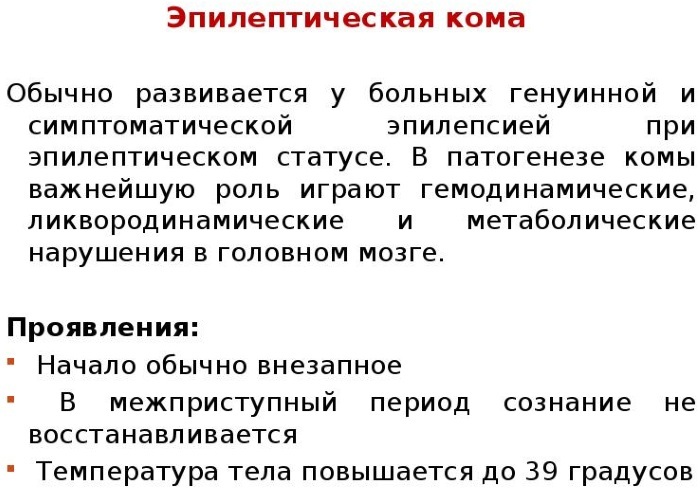
The blood pressure of such a patient is always lowered, and rare convulsions run through the body. The oppressed state causes interrupted breathing and a rapid pulse, which can lead to death without medical intervention.
Cerebral
This type of pathology is associated with the formation of tumors in the central nervous system. Coma develops gradually, starting with constant vomiting, headache and problems with the use of liquid food. As the tumor grows and the coma is approaching, it is also possible to observe the constant choking of the patient with water or any kind of liquid.
The appearance of a coma in this case occurs if the tumor correcting treatment was not carried out in full. Diagnosis of the condition occurs during an MRI of the brain, as well as a blood test that detects a high protein content.
The development of a cerebral coma is also possible with a brain abscess that develops against the background of complications of angina, sinusitis or otitis media. One of the main symptoms of this condition is also a sharp increase in body temperature.
Hungry
It occurs in patients suffering from dystrophy of the 3rd degree and practicing severe fasting. Quite often, such a pathology is also encountered by people who practice a protein diet and are faced with a protein deficiency, which provokes a disruption in the work of all functions of the brain.
With the gradual development of pathology, one can notice:
- frequent "hungry patient fainting";
- severe weakness;
- rapid breathing;
- tachycardia.
During a coma, a person's body temperature and blood pressure are in a low state. Decreased blood and glucose biochemistry is also observed.
Minengial
Pathology is directly related to the development of intoxication of the body as a result of meningococcal infection. In this case, the pre-comic stage is characterized by the presence of strong, constant headaches and the inability to lift up the extended leg (involuntarily bending at the knees).
The patient is also unable to simply tilt his head forward without instantly bending the knees. As the coma develops, it is also possible to attach a necrotic rash that occurs on the mucous membranes and the surface of the skin.
Diagnosis of the condition is possible after a lumbar puncture, which makes it possible to establish the presence of a dark cerebrospinal fluid, with a high content of protein and bloody bodies.
Hypoglycemic
A coma occurs in people with diabetes mellitus when the amount of glucose in the blood drops below 2 mmol / l. 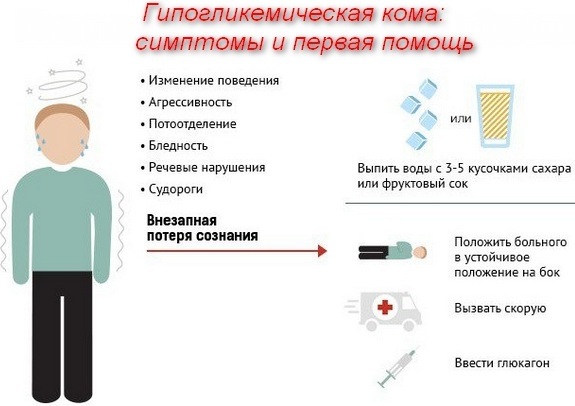 Before the onset of a coma, the patient often complains of a strong feeling of hunger, which appears regardless of the last meal.
Before the onset of a coma, the patient often complains of a strong feeling of hunger, which appears regardless of the last meal.
Diabetic
The pathology is caused by a strong increase in the amount of glucose in the blood and most often appears in people with diabetes mellitus.
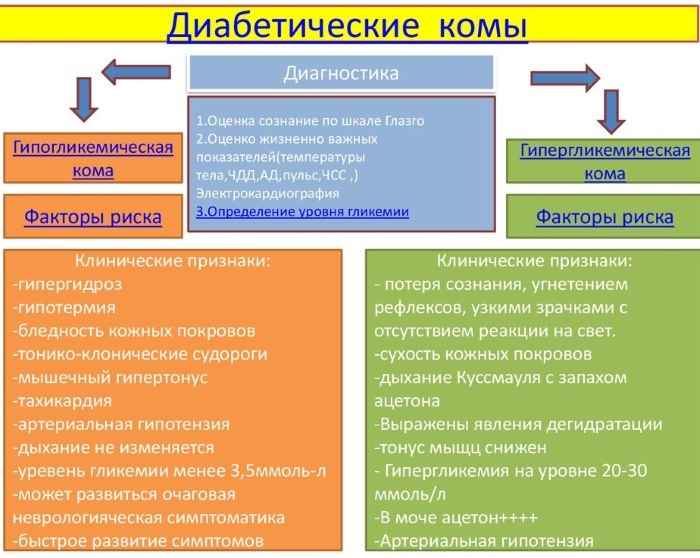
In addition to the high number of dextrose, it is also characterized by a distinct smell of acetone from the mouth of the patient.
Stages of development of the disease
The development and course of a coma occurs in several stages:
| Precoma | A condition preceding falling into a coma and lasting from a few minutes to 2-3 hours. The patient's consciousness at this moment can be confused, and the period of detachment and fatigue can be replaced by sudden excitement. Basic reflexes can be preserved, but accompanied by a loss of clear coordination. |
| Coma I degree | It is manifested by an inhibited reaction to external stimuli with simultaneous difficult contact with the patient. The patient is also able to drink fluids and react to bright light. |
| Coma II degree | It is accompanied by impaired contact with the patient, poor response to external stimuli and constriction of the pupils. Muscle tone, alternating relaxation and compression of the limbs are also noted. Possible respiratory failure and involuntary emptying of the bladder. |
| Coma III degree | At this stage, there is a loss of consciousness and the absence of any reaction to external stimuli. The patient's pupil is constricted and does not respond to bright light, muscle tone is increased, and seizures may occur. The patient's blood pressure and body temperature decrease, and the natural respiratory process is disturbed. In the absence of stabilization of the patient's condition, the patient enters the stage of gradual dying of the body. |
| Coma IV degree (transcendental coma) | It is characterized by a complete lack of consciousness, reaction to external stimuli, low body temperature and muscle tone. A person in this state is not able to breathe on his own, therefore he is connected to a ventilator. During this stage, a thermal state also gradually develops, in which the organs and tissues of the body gradually die off. |
Symptoms and Signs
In a person, the main symptom of a coma is considered to be the lack of contact of the patient with the enclosing world (consciousness) and the suspension of any mental activity. The rest of the signs can vary significantly depending on the stage and development of the pathology, as well as the cause that caused the brain damage.
| Temperabody tour | In the initial stages, a coma caused by overheating of the body can be accompanied by temperatures up to + 42 ° C. The condition caused by narcotic or psychotropic poisoning, on the contrary, causes a strong decrease in body temperature (+ 32- + 34 ° C). Later, by the 3rd stage, the temperature regime decreases sharply, reaching + 30 ° С. |
| Breathing rate | Slow, labored breathing occurs when thyroid hormone levels are abnormal, leading to coma from hypothyroidism. Deep breathing can be observed in brain tumors, diabetic or meningeal coma. |
| Heart rate | The appearance of bradycardia occurs in acute heart disease. An increase in the number of heartbeats accompanies a coma caused by an increase in intracranial pressure |
| Blood pressure fluctuations | Hypertension accompanies the coma caused by stroke. In diabetic coma, severe internal bleeding and myocardial infarction, low blood pressure is observed. |
| Skin color | Carbon monoxide poisoning provokes the appearance of a dark cherry-colored skin. Blue tissue indicates low oxygen levels in the blood. Blanching of the skin is accompanied by severe internal bleeding, and the formation of bruises near the ears and eyes occurs against the background of traumatic brain injury. |
| Contact with others | At mild stages of coma developmentIya the patient can involuntarily make various sounds. As the coma deepens, this ability disappears. |
| Reflexes | They are observed only in the initial stages of coma and stupor, disappear as the coma deepens, along with the reaction of the pupils to light. |
Diagnostic methods
Coma diagnostics requires the doctor to:
- finding out the reason that led to the development of a coma;
- direct determination of the lack of consciousness and its difference from other pathologies.
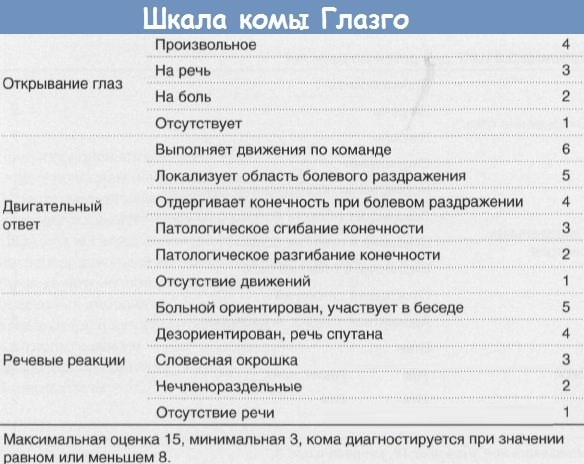
The doctor can find out the reasons for the appearance of a coma in the process of interviewing the patient's relatives (or witnesses to the pathology).
So, during the conversation, it turns out:
- whether the victim had complaints of feeling unwell;
- the presence of chronic pathologies;
- whether the patient was taking any medications.
The age of the patient is also of particular importance. So in young people, a coma state most often accompanies poisoning with psychotropic or hypnotic drugs, or arises from a traumatic brain injury.
Elderly people with a predisposition or concomitant pathologies of the cardiovascular or endocrine system, may become a victim of a coma due to a heart attack or stroke, or face critical jumps in glucose levels in blood.
In the process of visual examination, the doctor examines:
- blood pressure and heart rate;
- the patient's breathing pattern;
- the presence or absence of bruising and skin color;
- odor from the patient's mouth;
- the presence or absence of traces of injections on the hands and feet;
- body temperature.
Attention is also paid to the location of the patient's body, since:
- with hemorrhages and meningitis, the patient's head is thrown back and an increased tone of the neck muscles is observed;
- for an epileptic coma, the appearance of seizures throughout the body is characteristic;
- a cerebral stroke is accompanied by flaccid paralysis of certain parts of the body;
- for deep damage to the cerebral cortex, a complete absence of reflexes is characteristic.
Particularly important in diagnosing a coma is the reaction of the human body to sound and pain stimuli. The reaction of the patient manifested by the involuntary opening of the eyes in case of severe pain or exposure to an irritating sound is not a coma, but the closed eyes that remain unchanged, with the active actions of the doctor, diagnose coma condition.
The reaction of the patient's pupils to light is subject to a mandatory study, which helps to accurately determine the lesion located in the structure of the brain.
The peculiarity of the position of the pupils can also help determine the cause of the coma:
- with alcohol and toxicological poisoning, the pupils turn into black dots;
- with hypoxia, there is a different size of the pupils in both eyes;
- with severe trauma to the brain, the size of the pupils increases significantly.
Dilatation of the pupils with a complete non-response to exposure to bright light is also observed with an exorbitant coma and symptomatizes the onset of death of brain cells.
Additionally, when diagnosing a coma, it is carried out:
- CT and MRI, assessing structural changes in the cerebral cortex, detecting the appearance of neoplasms or establishing the cause that caused an increase in intracranial pressure;
- X-ray of the skull and spinal column in different projections;
- blood biochemistry, which determines metabolic failure in metabolism;
- study of the level of glucose, urea and ammonia in the blood;
- EEG, which makes it possible to assess the potential of the brain, varying from the cause that caused the coma.
After CT and MRI results that do not detect a tumor or brain injury, blood tests are ordered:
- hormones;
- for the content of toxic substances;
- bacterial culture.
Pathology treatment
Coma treatment consists of:
- in maintaining the patient's basic vital functions;
- in determining the cause that caused the development of a pathological condition.
The maintenance of vital functions is carried out immediately after the patient is immersed in an ambulance and consists of:
- in straightening a sunken tongue;
- in the removal of vomit from the oral and nasal cavities;
- in the establishment of an oxygen mask;
- in the insertion of the breathing tube;
- in the introduction of drugs that stabilize blood pressure and antiarrhythmic drugs;
- in conducting a closed heart massage;
After identifying the patient in the intensive care unit, the patient:
- in case of breathing problems, a breathing tube is inserted into the trachea and connected to a ventilator;
- to eliminate seizures, anticonvulsant drugs are administered;
- set a dropper for intravenous infusion of glucose solution;
- normalize body temperature (inject antipyretic drugs or cover the patient with heating pads and blankets when the indicators go down);
- wash the stomach if there is a suspicion of drug poisoning that caused a coma.

The second stage of treatment requires corrective therapy to eliminate the cause of the coma.
- in case of damage to the structure of the brain and the appearance of neoplasms, surgical intervention is urgently prescribed;
- diabetic or hypoglycemic coma require normalization of the amount of sugar in the blood;
- detection of renal failure requires hemodialysis.
- in case of cardiovascular pathologies, the heart rate is stabilized and therapy is carried out aimed at eliminating the consequences of a heart attack or stroke.
Feeding a person in a coma is done through a tube or intravenously. Also, without fail, measures are prescribed to prevent the appearance of pressure ulcers and correct breathing parameters.
Disease prognosis
Coma in humans (signs differ depending on the type of disease) - borderline state, development and exit of which directly depends on the degree of damage to the structure of the brain and the reasons that caused the appearance pathology.
- In case of coma of the 1st degree, doctors give a favorable prognosis, and complete recovery of a person is not accompanied by the appearance of residual phenomena.
- For type II and III coma, the prognosis of doctors is most often ambiguous, and the condition itself can result in both complete cure and death.
- Coma IV type in most cases ends with the death of the patient.
Timely detected pathology and high-quality corrective treatment are also of great importance.
Relatives of the patient talking to him, reading aloud their favorite books, telling news about the family and loved ones can also contribute to a faster recovery of a person from a coma. Visits to relatives should in no case be limited, because in most cases it is they that lead to the patient's exit from the coma.
Coming out of a coma
The return of a person to a normal state after a coma occurs gradually. At first, the functions of the central nervous system are restored, and then reflexes are normalized.
During recovery, you may also experience:
- impaired consciousness;
- delusions and hallucinations;
- motor restlessness;
- discoordinated movement;
- severe cramps.
The person who has come out of a coma is completely unaware of what happened and does not remember what exactly led to the loss of consciousness. Also, the patient may not understand the severity of his condition and should be under the close supervision of a doctor.
A coma in a person is a serious pathological condition that can lead to death, caused by deep damage to the brain and impaired mental functions.
Coma developing under the influence of physical or chemical reasons requires carefully coordinated, resuscitation actions of doctors and correct medical treatment aimed at eliminating not only the signs, but also the cause the development of pathology and is able in most cases to return the patient to a normal lifestyle and restore all vital body functions.
Coma video
What is a coma and its stages:

